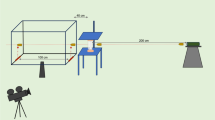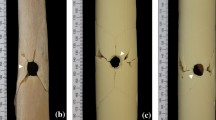Abstract
In contrast to cranial gunshot trauma, diagnosis and interpretation of gunshot trauma to long bones remains difficult and controversial. The aim of this study is to review the published literature on fracture patterns resulting from gunshot trauma in human long bones, and to use the described characteristics to provide practical guidance for the forensic anthropologist. In order to achieve this, medical and forensic publications on this topic were reviewed. Several types of fractures, such as linear, oblique, comminuted and butterfly fractures, have been observed in either the shaft or the ends of long bones. Indirect fractures that are not caused by bullets striking bone directly but by bullet-induced forces to the surrounding soft tissue have been found as well. Some of these fractures are related to a specific context or mechanism which might help in the forensic reconstruction of events. It is recommended that future research should focus on available medical data to provide more detailed descriptions on fracture patterns for forensic purposes. Experimentation with bone surrogates and computer modelling might also provide better and more realistic reconstructions of gunshot trauma in the future and provide valuable insights for its diagnosis and interpretation in forensic anthropology.

Similar content being viewed by others
Availability of data and material
Not applicable.
Code availability
Not applicable.
Change history
07 June 2022
A Correction to this paper has been published: https://doi.org/10.1007/s12024-022-00487-0
References
Berryman HE. A systematic approach to the interpretation of gunshot wound trauma to the cranium. Forensic Sci Int. 2019;301:306–17. https://doi.org/10.1016/j.forsciint.2019.05.019.
Tersigni-Tarrant MTA, Shirley NR. Forensic anthropology: an introduction. CRC Press; 2012.
Woźniak KJ, Moskała M, Grabherr S. Gunshot trauma. In: Grabherr S, Grimm JM, Heinemann A, editors. Atlas of postmortem angiography. Springer; 2016. p. 453–90.
Hart GO. Fracture pattern interpretation in the skull: differentiating blunt force from ballistics trauma using concentric fractures. J Forensic Sci. 2005;50(6):1–6.
Symes SA, l’Abbé, Ericka N, Chapman EN, Wolff I, Dirkmaat, Dennis C. Interpreting traumatic injury to bone in medicolegal investigations. In: Dirkmaat, Dennis C, editor. A companion to forensic anthropology. Blackwell Publishing; 2012. pp. 340–88.
Witchi TH, Omer GE. The treatment of open tibial shaft fractures from Vietnam War. J Trauma. 1970;10(2):105–11.
Ryan JR, Hensel RT, Salciccioli GG, Pedersen HE. Fractures of the femur secondary to low-velocity gunshot wounds. J Trauma. 1981;21(2):160–2.
Smith HW, Wheatley KK. Biomechanics of femur fractures secondary to gunshot wounds. J Trauma. 1984;24(11):970–7.
Leffers D, Chandler RW. Tibial fractures associated with civilian gunshot injuries. J Trauma. 1985;25(11):1059–64.
Rose SC, Keith Fujisaki C, Moore EE. Incomplete fractures associated with penetrating trauma: etiology, appearance, and natural history. J Trauma. 1988;28(1):106–9.
Tornetta P, Tiburzi D. Anterograde interlocked nailing of distal femoral fractures after gunshot wounds. J OrthopTrauma. 1994;8(3):220–7.
Rodrigues RL, Sammer DM, Chung KC. Treatment of complex below-the-elbow gunshot wounds. Ann Plast Surg. 2006;56(2):122–7.
Dougherty PJ, Vaidya R, Silverton CraigD, Bartlett C, Najibi S. Joint and long-bone gunshot injuries. J Bone Joint Surg Am. 2009;91(4):980–97.
Huelke DF, Buege LJ, Harger JH. Bone fractures produced by high velocity impacts. Am J Anat. 1967;120(1):123–31.
Huelke DF, Harger JH, Buege LJ, Dingman HG, Harger DR. An experimental study in bio-ballistics. Femoral fractures produced by projectiles. J Biomechanics. 1968;1(2):97–105.
Berryman HE, Gunther WM. Keyhole defect production in tubular bone. J For Sci. 2000;45(2):483–7.
Smith OC, Pope ElayneJ, Symes SA. Look until you see: identification of trauma in skeletal material. In: Steadman DW, editor. Hard evidence: case studies in forensic anthropology. 2nd ed. Routledge; 2003. pp. 337–63.
Galloway A, Zephro L. Forensic medicine of the lower extremity. Humana Press; 2005.
Kimmerle EH, Baraybar JP. Skeletal trauma: identification of injuries resulting from human right abuse and armed conflict. Oxfordshire, UK: Taylor and Francis; 2008.
Kieser DC, Carr DJ, Leclair SCJ, Horsfall I, Theis JC, Swain MV, et al. Gunshot induced indirect femoral fracture: mechanism of injury and fracture morphology. J R Army Med Corps. 2013;159(4):294–9. https://doi.org/10.1136/jramc-2013-000075
Kieser DC, Riddell R, Kieser JA, Theis J, Swain MV. Bone micro-fracture observations from direct impact of slow velocity projectiles. J Arch Mil Med. 2014;2(1):1–6. https://doi.org/10.5812/jamm.15614.
Bir C, Andrecovich C, DeMaio M, Dougherty PJ. Evaluation of bone surrogates for indirect and direct ballistic fractures. Forensic Sci Int. 2016;261(1):7. https://doi.org/10.1016/j.forsciint.2016.01.023.
Martrille L, Symes SA. Interpretation of long bones ballistic trauma. Forensic Sci Int. 2019;302:1–10. https://doi.org/10.1016/j.forsciint.2019.109890.
Christensen A, Smith M, Gleiber D, Cunningham D, Wescott D. The use of X-ray computed tomography technologies in forensic anthropology. Forensic Anthropol. 2018;1(2):124–40.
Burke MP. Forensic pathology of fractures and mechanisms of injury—postmortem CT scanning. CRC Press; 2012.
Thali MJ, Yen K, Vock P, Ozdoba C, Kneubuehl BP, Sonnenschein M, et al. Image-guided virtual autopsy findings of gunshot victims performed with multi-slice computed tomography (MSCT) and magnetic resonance imaging (MRI) and subsequent correlation between radiology and autopsy findings. Forensic Sci Int. 2003;138(1–3):8–16.
Moraitis K, Spiliopoulou C. Identification and differential diagnosis of perimortem blunt force trauma in tubular long bones. Forensic Sci Med Pathol. 2006;2(4):221–9.
Kieser DC, Kanade S, Waddell NJ, Kieser JA, Theis JC, Swain M v. The deer femur—a morphological and biomechanical animal model of the human femur. Biomed Mater and Eng. 2014;24(4):1693–703.
Kneubuehl BP, Thali MJ. The evaluation of a synthetic long bone structure as a substitute for human tissue in gunshot experiments. Forensic Sci Int. 2003;138(1–3):44–9.
Henwood BJ, Appleby-Thomas G. The suitability of Synbone® as a tissue analogue in ballistic impacts. J Mater Sci. 2020;55(7):3022–33. https://doi.org/10.1007/s10853-019-04231-y.
Jin Y, Mai R, Wu C, Han R, Li B. Comparison of ballistic impact effects between biological tissue and gelatin. J Mech Behav Biomed Mater. 2018;78:292–7. https://doi.org/10.1016/j.jmbbm.2017.11.033.
Ragsdale BD, Josselson A. Experimental gunshot fractures. J Trauma. 1988;28(1):109–15.
Jussila J, Leppäniemi A, Paronen M, Kulomäki E. Ballistic skin simulant. Forensic Sci Int. 2005;150(1):63–71.
Bir CA, Resslar M, Stewart S. Skin penetration surrogate for the evaluation of less lethal kinetic energy munitions. Forensic Sci Int. 2012;220(1–3):126–9. https://doi.org/10.1016/j.forsciint.2012.02.008.
Müller ME, Nazarian S, Koch P, Schatzker J. The comprehensive classification of fractures of long bones. Springer-Verlag; 1990.
Reber SL, Simmons T. Interpreting injury mechanisms of blunt force trauma from butterfly fracture formation. J Forensic Sci. 2015;60(6):1401–11.
Dixon DS. Keyhole lesions in gunshot wounds of the skull and direction of fire. J Forensic Sci. 1982;27(3):555–65.
Ryan RS, Munk PL. Radiology for the surgeon musculoskeletal case 32. Can J Surg. 2004;47(3):197–8.
Dougherty PJ, Sherman D, Dau N, Bir C. Ballistic fractures: indirect fracture to bone. J Trauma. 2011;71(5):1381–4.
Zhang X, Xu C, Wen Y, Luo S. The experimental and numerical study of indirect effect of a rifle bullet on the bone. Forensic Sci Int. 2015;257:473–80.
Cooper GJ, Ryan JM. Interaction of penetrating missiles with tissues: some common misapprehensions and implications for wound management. Br J Surg. 1990;77(6):606–10.
Li M, Ma YY, Fu RX, Feng TS. The characteristics of the pressure waves generated in the soft target by impact and its contribution to indirect bone fractures. J Trauma. 1988;28(S):104–9.
Sherman DC, Dougherty P, Bir CA. Indirect fractures to bones by ballistic injury. J Biomech. 2007;40(S2).
Alswat KA. Gender disparities in osteoporosis. J Clin Med Research. 2017;9(5):382–7.
Aris RM, Merkel PA, Bachrach LK, Borowitz DS, Boyle MP, Elkin SL, et al. Consensus statement: guide to bone health and disease in cystic fibrosis. J Clin Endocrinol Metab. 2005;90(3):1888–96.
Hollerman JJ, Fackler L, Coidweli M. Gunshot wounds: 1. Bullets, ballistics, and mechanisms of injury. AJR Am J Roentgenology. 1990;155:685–90.
Kieser DC, Carr DJ, Leclair SCJ, Horsfall I, Theis JC, Swain MV, et al. Clothing increases the risk of indirect ballistic fractures. J Orthop Surg Res. 2013;8(1).
Kneubuehl BP, Coupland RM, Rothshild A. Wound ballistics. Berlin Heidelberg: Springer-Verlag; 2011.
Quatrehomme G, I̊şcan MY. Analysis of beveling in gunshot entrance wounds. Forensic Sci Int. 1998;93(1):45–60.
Zátopková L, Hejna P. Fatal suicidal crossbow injury—the ability to act. J Forensic Sci. 2011;56(2):537–40.
Karger B, Sudhues H, Kneubuehl BP, Brinkmann B. Experimental arrow wounds: ballistics and traumatology. J Trauma Acute Care Surg. 1998;45(3):495–501.
Pomara C, D’Errico S, Neri M. An unusual case of crossbow homicide. Forensic Sci Med Pathol. 2007;3(2):124–7.
Cappella A, Castoldi E, Sforza C, Cattaneo C. An osteological revisitation of autopsies: comparing anthropological findings on exhumed skeletons to their respective autopsy reports in seven cases. Forensic Sci Int. 2014;244:315.e1-315.e10. https://doi.org/10.1016/j.forsciint.2014.09.003.
Humphrey C, Kumaratilake J. Ballistics and anatomical modelling — a review. Leg Med. 2016;23:21–9. https://doi.org/10.1016/j.legalmed.2016.09.002.
Pulen A, Kieser DC, Hooper G. A study into the viability of Synbone® as a proxy for Sus scrofa (domesticus) ribs for use with 5.56-mm open tip match ammunition in ballistic testing. Int J Legal Med. 2020;135(2):521–26. https://doi.org/10.1007/s00414-020-02416-8
Smith MJ, James S, Pover T, Ball N, Barnetson V, Foster B, Guy C, Rickman J, Walton V. Fantastic plastic? Experimental evaluation of polyurethane bone substitutes as proxies for human bone in trauma simulations. Leg Med. 2015;17:427–35. https://doi.org/10.1016/j.legalmed.2015.06.007.
Henwoond BJ, Appleby-Thomas G. The suitability of Synbone as a tissue analogue in ballistic impacts. J Mater Sci. 2020;55:3022–33. https://doi.org/10.1007/s10853-019-04231-y.
Author information
Authors and Affiliations
Contributions
AV: conceptualisation, methodology (incl. literature search and data analysis), investigation, visualisation, writing — original draft. WK: writing — review and editing. IG: initiative, supervision, validation, writing — review. R-JO: supervision, validation, writing — review.
Corresponding author
Ethics declarations
Ethics approval
Not applicable.
Consent to participate
Informed consent was not required for this study.
Conflict of interest
The authors declare no competing interests.
Additional information
Publisher's Note
Springer Nature remains neutral with regard to jurisdictional claims in published maps and institutional affiliations.
The original online version of this article was revised: In Fig. 1, Bone 3 and Bone 5 do not show the white lines indicating the fracture pattern.
Rights and permissions
About this article
Cite this article
Veenstra, A., Kerkhoff, W., Oostra, RJ. et al. Gunshot trauma in human long bones: towards practical diagnostic guidance for forensic anthropologists. Forensic Sci Med Pathol 18, 359–367 (2022). https://doi.org/10.1007/s12024-022-00479-0
Accepted:
Published:
Issue Date:
DOI: https://doi.org/10.1007/s12024-022-00479-0




